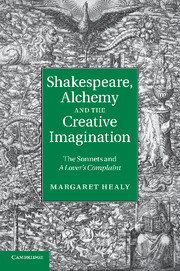Book contents
- Frontmatter
- Contents
- List of illustrations
- Acknowledgements
- A note on the texts
- Introduction
- 1 Alchemical contexts
- 2 Lovely boy
- 3 The dark mistress and the art of blackness
- 4 A Lovers Complaint by William Shake-speare
- 5 Inner looking, alchemy and the creative imagination
- 6 Conclusion: Shakespeare's poetics of love and religious toleration
- Notes
- Index
5 - Inner looking, alchemy and the creative imagination
Published online by Cambridge University Press: 18 December 2013
- Frontmatter
- Contents
- List of illustrations
- Acknowledgements
- A note on the texts
- Introduction
- 1 Alchemical contexts
- 2 Lovely boy
- 3 The dark mistress and the art of blackness
- 4 A Lovers Complaint by William Shake-speare
- 5 Inner looking, alchemy and the creative imagination
- 6 Conclusion: Shakespeare's poetics of love and religious toleration
- Notes
- Index
Summary
PART I THE INWARD TURN: DOING ‘MIND’ IN ‘CHARACTER’
If there be nothing new, but that which is
Hath been before, how are our brains beguiled,
Which, labouring for invention, bear amiss
The second burden of a former child?
O that record could with a backward look,
Even of five hundred courses of the sun,
Show me your image in some antique book,
Since mind at first in character was done.
(Sonnet 59, 1–8)Doing ‘mind … in character’ had a long and distinguished heritage by the time Shakespeare took up his pen at the turn of the seventeenth century. Indeed, the ‘backward look’ that the words of Sonnet 59 prompt might help to establish the limits of his introspective innovation. How distinctive is Shakespeare's poetic ‘child’? The Bard appears to have set himself a challenge of ‘invention’, and readers are invited to consider whether or not he has laboured successfully. Is this poet's brain ‘beguiled’ or original? It is time to take that ‘backward look’.
For the Renaissance, Petrarch was, of course, a towering landmark along this particular literary pathway and his famous ‘Letter IV’ describing his ascent of Mount Ventoux implicitly reveals his own profound indebtedness to ‘antique’ models, prime among them the colossus St Augustine. ‘Driven by the sole desire to see the famous altitude of this place’ and assisted by the ‘vigour of [his] will’, Petrarch attempts to ascend the highest of the peaks, which the forest dwellers call ‘The Son’.
- Type
- Chapter
- Information
- Shakespeare, Alchemy and the Creative ImaginationThe Sonnets and A Lover's Complaint, pp. 157 - 194Publisher: Cambridge University PressPrint publication year: 2011



